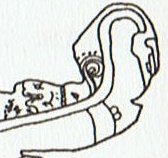Bb9.9
There were 6 days from Canopus (52° 40′ S) up to
Sirius (16° 39′ S) at the Nose of the Great Dog. Or viewed
upside down as south of the equator - down from Canopus to
Sirius.
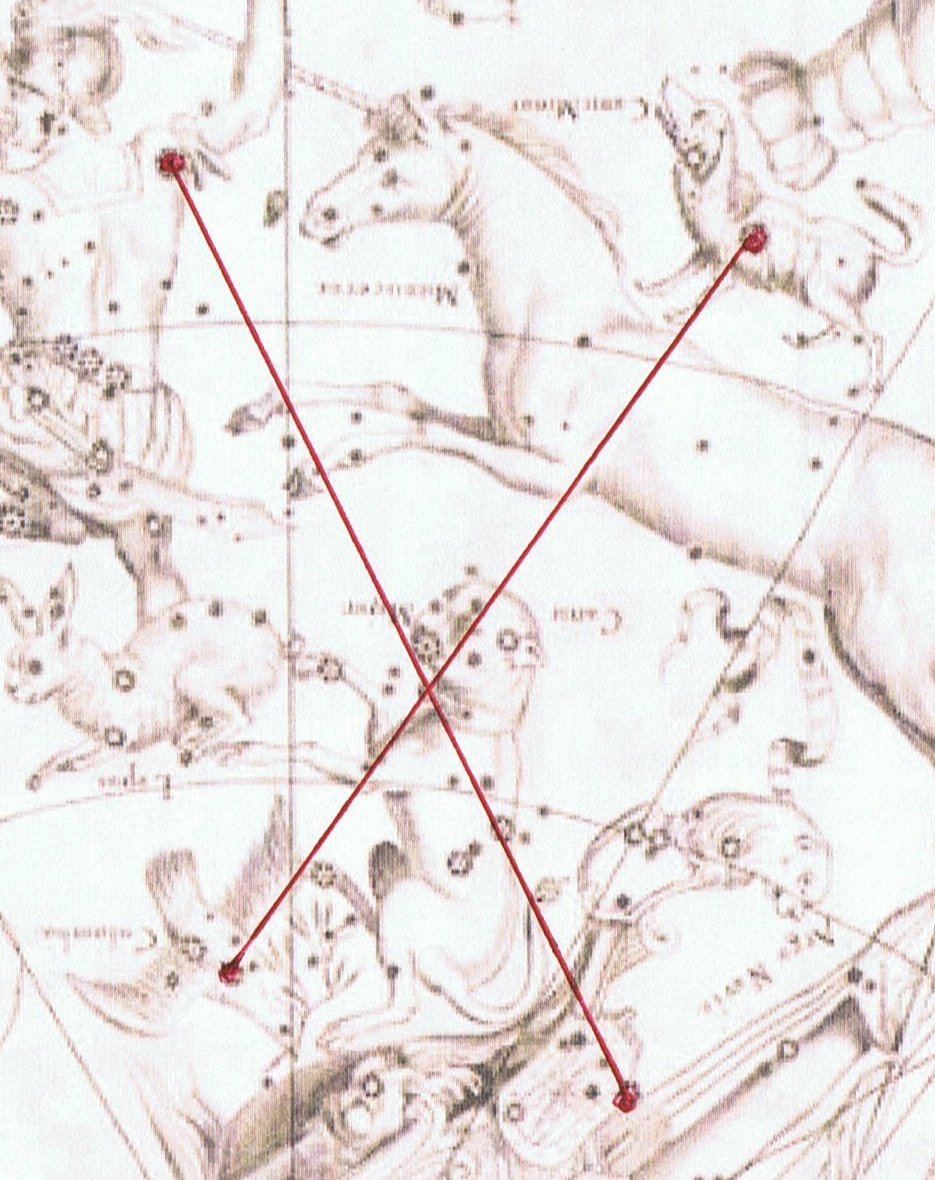
|
RIGHT
ASCENSION DAYS AT THE FULL MOON: |
 |
 |
 |
 |
 |
|
Bb9-1 (327) |
Bb9-2 |
Bb9-3 (750) |
Bb9-4 |
Bb9-5 (325 +
6) |
|
ξ Orionis
(92.5) |
Al Han'ah-4 (Brand)
/
Maru-sha-pu-u-mash-mashu-7
(Front of the Mouth of the Twins)
TEJAT PRIOR =
η
Gemini
(93.4),
γ
Monocerotis (93.5),
κ
Aurigae
(93.6),
κ
Columbae (93.8)
*52.0 = *93.4 - *41.4 |
FURUD = ζ Canis Majoris
(94.9) |
Well-22 (Tapir)
/
Arkū-sha-pu-u-mash-mashu-8
(Back of the Mouth of the Twins)
δ
Columbae (95.2),
TEJAT POSTERIOR =
μ
Gemini, MIRZAM (The Roarer) =
β
Canis Majoris (95.4),
CANOPUS
(Canopy) =
α
Carinae
(95.6),
ε
Monocerotis (95.7),
ψ1
Aurigae (95.9)
*54.0 = *95.4 - *41.4 |
No star listed (96) |
|
APRIL 18 (108) |
19
(*93 - *64 = *29) |
20 (80 + 30) |
21 (111 = 107 + 4) |
22 |
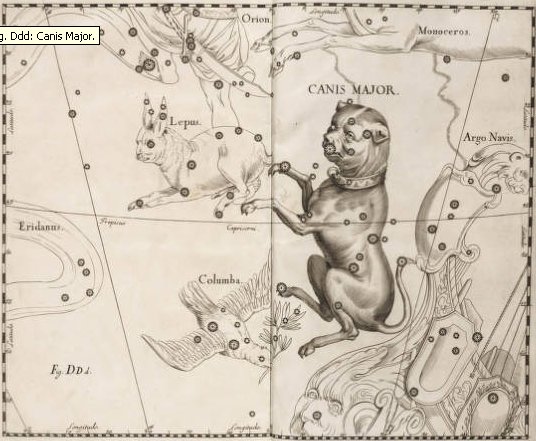 |
|
HELIACAL
STARS: |
|
OCT 18 (108
+ 183) |
19 |
20 |
21 |
22 (295) |
MENKAR (α Ceti) |
η Sagittarii
(*276) |
KAUS MEDIUS |
KAUS
AUSTRALIS |
KAUS BOREALIS |
|
Solstice (355) |
Dec 22 |
23 |
CHRISTMAS EVE |
25 (175 + 184) |
|
I te tagata moe |
ki to vae |
ko te moa pu - ko te moa
tegetege |
ko te moa uha pu |
e tagata ia |
|
Gete. M.: Whakangete,
to urge on a horse. Ngetengete, to make a
clicking sound with the tongue. to click with
the tongue, as to a horse; to chirrup. To
express surprise or sorrow. Cf. ketekete,
to express surprise or regret. H.: neke,
an indistinct sound, as scratching on a rough
board; to make the noise of scratching; to
scratch. Cf. ekeeke, to be in pain;
displeasure, arising from an offence; the
feeling which one has when that which he prizes
is spoken against or injured. T.: ete, to
flinch; eteete, to be shocked disgusted,
or ashamed. Cf. paete, to be made angry.
To.: cf. ketekete, to chirrup; kekete,
to chirp; to chatter. Text Centre.
Uha. Hen; female (familiar): taaku
uha = taaku vî'e, my wife, or my daughter
(i.e. taaku poki). Vanaga. Female. T
Pau.: koufa, female of animals. Mq.:
uha. id. Ta.: ufa, uha, id.
Ma.: uwha, uha, id. Uhamau
(uha - mau 7), to brood, to hatch.
Churchill. Tonga, Niuē:
uha, rain. Viti: utha, rain.
Churchill 2. |
|
 |
*5.6 |
 |
*3.6 |
 |
 |
*5.3 |
 |
|
CANOPUS
(*95.6) |
SIRIUS
(*101.2) |
ADARA
(*104.8) |
MULIPHEIN (*105.8) |
ALUDRA
(*111.1) |
|
St John's
Day (175) |
June 30
(175 + 6) |
July 3 |
4
(185) |
10 (175 +
16) |
|
The minimum number of nights
before the return to visibility of a
significant star was 16:
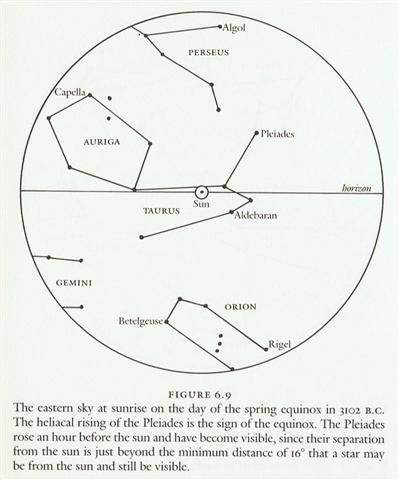 |
 |
 |
 |
 |
 |
|
Bb9-6
(300 + 32) |
Bb9-7 |
Bb9-8 |
Bb9-9
(2 * 378) |
Bb9-10 (330 + 6) |
|
RIGHT
ASCENSION DAYS AT THE FULL MOON: |
|
β Monocerotis,
ν Gemini
(97.0) |
No star listed (98) |
Aurigae (99.4), ψ2 Aurigae (99.5)
GEMMA (α Cor. Bor.) |
ψ4 Aurigae (100.5),
MEBSUTA (Outstretched) = ε Gemini
(100.7) |
SIRIUS = α Canis Majoris
(101.2),
ψ5 Aurigae (101.4),
ν Gemini (101.6), ψ6 Aurigae (101.7)
*60.0 = *101.4 - *41.4 |
|
... In other words, the ancient Druidic
religion based on the oak-cult will be
swept away by Christianity and the door
- the god Llyr - will languish forgotten
in the Castle of Arianrhod, the
Corona Borealis. This helps us to
understand the relationship at Rome of
Janus and the White Goddess Cardea who
is ... the Goddess of Hinges who came to
Rome from Alba Longa. She was the hinge
on which the year swung - the ancient
Latin, not the Etruscan year - and her
importance as such is recorded in the
Latin adjective cardinalis - as
we say in English 'of cardinal
importance - which was also applied to
the four main winds; for winds were
considered as under the sole direction
of the Great Goddess until Classical
times ... |
|
OCT 23 |
24 |
25 |
26
(299) |
27 (181 + 183 - 64) |
|
ku oho mai ki to rima |
e manu rere - ki to
huki |
E Rei vage rua |
ko te tagata kua oho
- kua tagi mai ki
te vai |
ko te Rei |
|
Tagi. To cry, to
weep, to moan; tatagi, to cry
much; to cry loudly: he-tagi te
karaga; tagata rava, tagi karaga,
bawling, vociferous person. Vanaga. To
cry, to bark, to mew, to bawl, to whine,
to ring, to wail, to prattle, to weep,
lamentation, condolence, to regret, to
affect, to wish, to will, to choose,
earnestness; tae tagi, inhuman,
insensible, to refuse, to renounce;
tagi kiukiu, ring of a bell; tagi
rakerake, to wish one ill;
tagi kore, indifferent; manava
tagi, to affect; hakatagi, to
cause to weep, to make resound, to ring;
tagitagi, to covet; tatagi,
cry mourning, grief, lamentation, to
groan, to weep, to be affected, to grow
tender; tatagi tahaga,
inconsolable; tatagihaga,
friendship. Churchill. |
Sirius (the brightest star in the night) behaved remarkably
by following in the shadow of the precessional Sun, from
where the position of the rest of the stars in the
canopy could be considered as approximately fixed in the
background.
... The Sothic cycle was based on
what is referred to in technical jargon as 'the periodic
return of the heliacal rising of Sirius', which is the
first appearance of this star after a seasonal absence,
rising at dawn just ahead of the sun in the eastern
portion of the sky. In the case of Sirius the interval
between one such rising and the next amounts to
exactly 365.25 days - a mathematically harmonious
figure, uncomplicated by further decimal points, which
is just twelve minutes longer than the duration of the
solar year ...

There are 24 * 30 = 720 minutes in a day, and 720 + 12 =
732 = 2 * 366 = 4 * 183 = 12 * 61.
It might therefore have been natural to consider Sirius as the
great one who at the beginning of each year would
restore all the waters Canopus had consumed.
... The Pythagoreans make Phaeton
fall into Eridanus, burning part of its water, and
glowing still at the time when the Argonauts passed by.
Ovid stated that since the fall the Nile hides its
sources. Rigveda 9.73.3 says that the Great Varuna has
hidden the ocean. The Mahabharata tells in its own style
why the 'heavenly Ganga' had to be brought down. At the
end of the Golden Age (Krita Yuga) a class of
Asura who had fought against the 'gods' hid
themselves in the ocean where the gods could not reach
them, and planned to overthrow the government. So the
gods implored Agastya (Canopus, alpha Carinae =
Eridu) for help. The great Rishi did as he was bidden,
drank up the water of the ocean, and thus laid bare the
enemies, who were then slain by the gods. But now, there
was no ocean anymore! Implored by the gods to fill the
sea again, the Holy One replied: 'That water in sooth
hath been digested by me. Some other expedient,
therefore, must be thought of by you, if ye desire to
make endeavour to fill the ocean ...

... In ancient Egypt they thought
Sirius was behind the yearly rise of the Nile ... the
seasonal cycle, throughout the ancient world, was the
foremost sign of rebirth following death, and in Egypt
the chronometer of this cycle was the annual flooding of
the Nile. Numerous festival edifices were constructed,
incensed, and consecrated; a throne hall wherein the
king should sit while approached in obeisance by the
gods and their priesthoods (who in a crueler time would
have been the registrars of his death); a large court
for the presentation of mimes, processions, and other
such visual events; and finally a palace-chapel into
which the god-king would retire for his changes of
costume ...
.jpg)
These restored waters following upon the rise of Sirius
at the horizon in the east were
destined to once again fill the waiting dry agricultural canals:
 |
 |
 |
 |
 |
|
Bb9-11 |
Bb9-12 (293
+ 45) |
Bb9-13 (760) |
Bb9-14 (340) |
Bb9-15 (→ 135) |
|
RIGHT
ASCENSION DAYS AT THE FULL MOON: |
|
τ
Puppis (102.2),
ψ7 Aurigae (102.4)
*61.0 = *102.4 - *41.4 |
Mash-mashu-sha-Risū-9 (Twins of the
Shepherd)
θ
Gemini (103.0),
ψ8 Aurigae
(103.2),
ALHENA =
γ
Gemini
(103.8),
ψ9
Aurigae (103.9) |
ADARA (Virgins) = ε Canis Majoris
(104.8) |
ω
Gemini (105.4), ALZIRR (Button) =
ξ
Gemini
(105.7),
MULIPHEIN
(Oaths) =
γ
Canis Majoris
(105.8),
MEKBUDA (Contracted) =
ζ
Gemini
(105.9)
*64.0 = *105.4 - *41.4 |
7h (106.5)
No star listed (106) |
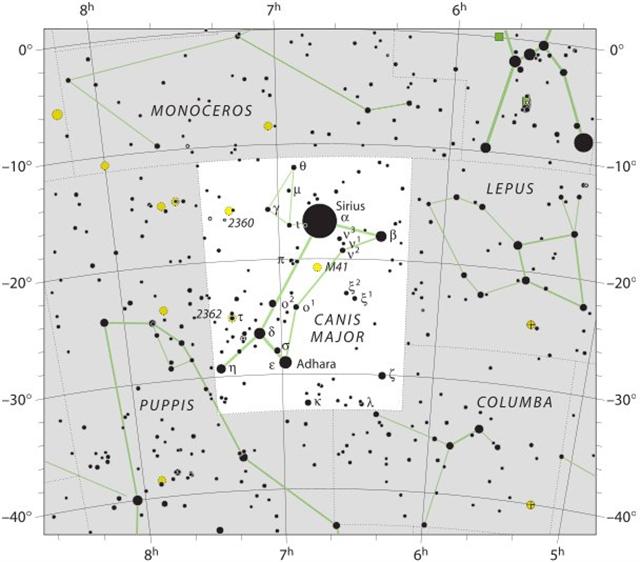 |
|
OCT
28 (301) |
29 |
30 |
31 |
NOV 1
(305) |
|
kua huki |
ku hoti
i te vai |
mai ai i te Rei |
ma te hokohuki |
mai
tagi ai i te vai |
|
SOGDIAN: |
|
Wabir |
Well Mouth |
α Andromedae (Sirrah),
γ Pegasi (Algenib) |
1.8 |
Mar 22 (81) |
|
Riwand |
Rich |
ζ (Revati)
Piscium |
16.9 |
April 6 (96) |
|
Bashish |
Protector |
β (Sheratan),
γ (Mesarthim) Arietis |
27.4 |
April 17 (107) |
|
Barv |
Forerunners |
μ, 33, 35, 39,
41 (Bharani)
Arietis |
41.4 |
May 1 (121) |
|
Baharu |
Follower |
α (Aldebaran)
Tauri |
68.2 |
May 28 (148) |
|
Marezānā |
Twins |
λ (Heka),
φ¹, φ² Orionis |
83.2 |
June 12 (163) |
|
Ghataf |
Canal |
γ (Alhena),
η (Tejat Prior), μ (Tejat
Posterior), ν, ξ (Alzirr) Gemini |
103.8 |
July 2 (183) |
|
PERSIAN: |
|
Miyan |
Well Mouth |
α
Andromedae (Sirrah),
γ Pegasi (Algenib) |
1.8 |
Mar 22 (81) |
|
Kaht |
Cord |
ε,
ζ (Revati)
Piscium |
16.9 |
April 6 (96) |
|
Padevar |
Protecting Pair |
β (Sheratan),
γ (Mesarthim) Arietis |
27.4 |
April 17 (107) |
|
Pish Parvis |
Forerunners |
μ, 33, 35, 39,
41 (Bharani)
Arietis |
41.4 |
May 1 (121) |
|
Paha |
Follower |
α
(Aldebaran)
Tauri |
68.2 |
May 28 (148) |
|
Aveçr |
Coronet |
λ (Heka),
φ¹, φ² Orionis |
83.2 |
June 12 (163) |
|
Rakhvad |
Canal |
γ (Alhena),
η (Tejat Prior), μ
(Tejat Posterior), ν, ξ
(Alzirr) Gemini |
103.8 |
July 2 (183) |
|
KHORASMIAN: |
|
Wabir |
Well Mouth |
α
Andromedae (Sirrah),
γ Pegasi (Algenib) |
1.8 |
Mar
22 (81) |
|
Zidadh |
Rich |
ζ
(Revati)
Piscium |
16.9 |
April
6 (96) |
|
Farankhand |
Forerunners |
μ,
33, 35, 39, 41
(Bharani) Arietis |
41.4 |
May 1
(121) |
|
Baharu |
Follower |
α
(Aldebaran) Tauri |
68.2 |
May
28 (148) |
|
Ikhma |
Twins |
λ
(Heka), φ¹, φ²
Orionis |
83.2 |
June
12 (163) |
|
Ghawthaf |
Canal |
γ
(Alhena), η
(Tejat Prior), μ (Tejat Posterior), ν, ξ (Alzirr) Gemini |
103.8 |
July
2 (183) |
 |
This Canal was stretching from
ν Gemini
(in day 177 = 6 * 29½) to Alzirr (ξ)
in July 4 (185 = 121 + 64).
... Nun is thought to have come from a pictogram
of a snake (the Hebrew word for snake, nachash
begins with a Nun and snake in Aramaic is nun)
or eel. Some have hypothesized a hieroglyph of a fish in
water for its origin (in Arabic,
nūn means large fish or whale). The
Phoenician letter was named
nūn 'fish', but the glyph has been suggested to
descend from a hypothetical Proto-Canaanite
nahš 'snake', based on the name in
Ethiopic, ultimately from a hieroglyph representing a
snake.
... Nahš in modern Arabic literally means
'bad luck'. The cognate letter in Ge'ez and descended
Semitic languages of Ethiopia is nehas, which
also means 'brass'.
... In rongorongo times the last Greek lettered star
in Orion (ξ)
rose with the Sun in June 21. The letter seems to have
originated from the Phoenician letter samekh
(tent peg, supporting prop), which in turn may have been
derived from the ancient Egytian djed column ...
In day 183 (6 days after ν
Gemini) was not only Alhena
(γ Gemini, 1.93) but also the star ψ8 Aurigae, evidently
too faint (6.46) to have been illustrated in the star
map below:

... Wikipedia: In writing, the early letter appears in
an angular shape ( ).
There were early graphical variants that omitted the
stem, 'chickenfoot-shaped psi', as: ).
There were early graphical variants that omitted the
stem, 'chickenfoot-shaped psi', as:
 or
or

In later research it was postulated that the
[Phoenician] alphabet is actually two complete lists,
the first dealing with land agriculture and activity,
and the second dealing with water, sea and fishing.
The first half beginning
with Alef - an ox, and ending with Lamed -
a whip. The second list begins with Mem - water,
and continues with Nun - fish, Samek -
fish bones, Ayin - a water spring, Peh -
the mouth of a well, Tsadi - to fish, Kof,
Resh and Shin are the hook hole, hook head
and hook teeth, known to exist from prehistoric times,
and the Tav is the mark used to count the fish
caught ...
Tradition might have required a very faint star to
be found from drawing a straight line from a more
luminant star, like how the
Fox up in Ursa
Major was joined to Spica in Virgo.

From Alhena in the Canal to the star named
Middle (δ Gemini)
there were 189 (July 8) - 183 (July 2) = 6 days:
 |
 |
 |
 |
 |
|
Ga2-13 |
Ga2-14 |
Ga2-15
(45) |
Ga2-16 |
Ga2-17 |
|
MAY 3
(123) |
4 |
5 (*109 - *64 = *45) |
6 |
7
(127) |
|
July 6 |
7
(188) |
8 |
9 |
10 |
 |
 |
 |
 |
 |
|
Bb9-16 (763) |
Bb9-17 |
Bb9-18 |
Bb9-19 (345) |
Bb9-20 (339 + 7) |
|
RIGHT
ASCENSION DAYS AT THE FULL MOON: |
|
WEZEN (Weight) =
δ
Canis Majoris
(107.1),
τ
Gemini (107.7),
δ
Monocerotis (107.9) |
No star listed (108) |
λ Gemini (109.4),
WASAT (Middle) = δ Gemini
(109.8)
*68.0 = *109.4 - *41.4 |
No star listed (110) |
ALUDRA (Virgin) =
η
Canis Majoris
(111.1),
PROPUS = ι Gemini (111.4),
GOMEISA (Water-eyed) = β Canis Minoris
(111.6)
*70.0 = *111.4 - *41.4 |
|
ka viri te vai |
mai i haga ia -
koia - hakahumu i te vai - kia ki tata |
|
Viri.
1. To wind, to coil, to roll
up; he viri i te hau, to wind,
coil a string (to fasten something). 2.
To fall from a height, rolling over, to
hurl down, to fling down. Viriviri,
round, spherical (said of small
objects). Viviri te henua,
to feel dizzy (also: mimiro te henua).
Vanaga. To turn in a circle, to clew up,
to groom, to twist, to dive from a
height, to roll (kaviri).
Hakaviri, crank, to groom, to turn a
wheel, to revolve, to screw, to beat
down; kahu hakaviri, shroud.
Viriga, rolling, danger. Viriviri,
ball, round, oval, bridge, roll, summit,
shroud, to twist, to wheel round, to
wallow. Hakaviriviri, to roll, to
round; rima hakaviriviri, stroke
of the flat, fisticuff. P Pau.:
viriviri, to brail, to clew up;
koviriviri, twisting. Mgv.: viri,
to roll, to turn, to twist; viviri,
to fall to the ground again and again in
a fight. Mq.: vii, to slide, to
roll, to fall and roll. Ta.: viri,
to roll up, to clew up. Viritopa,
danger. Mgv.: Viripogi, eyes
heavy with sleep. Mq.: viipoki,
swooning, vertigo. Churchill. Viti:
vili, to pick up fallen fruit or
leaves ... In Viti virimbai has
the meaning of putting up a fence (mbai
fence); viri does not appear
independently in this use, but it is
undoubtedly homogenetic with Samoan
vili, which has a basic meaning of
going around; virikoro then
signifies the
ring-fence-that-goes-about, sc. the
moon. In the Maori, aokoro is the
cloud-fence ... Churchill 2.
Humu. 1.
Tattooing on the feet. (Cf. Ta.: umu,
ornament.) 2. (umu). 3. Mq.: To
attach, to tie. Ha.: humu, to
fasten together by sewing. Churchill.
Tata.
1. To wash something. 2. To go;
he-tata-mai, to come, to appear, to
show up. Vanaga.
Tátá
- see tá.
Vanaga. 1. Agony, severe pain, apparent
death. 2. Next, proximity;
hakatata,
to bring close together. 3. To strike;
tata ei
taura, to flog, to lash. 4.
To wash, to clean, to soap, to rinse. 5.
To appear, to approach, to advance, to
present;
hakatata, to advance, to
propose, to accost. Churchill. |
 |
|
→
HELIACAL STARS: |
|
Al Baldah-19
(City)
AL BALDAH = π Sagittarii, ALPHEKKA
(Dish) MERIDIANA = α Cor. Austr.
(290.1), β Cor. Austr. (290.2) |
ALADFAR (The Talons) =
η
Lyrae
(291.1),
NODUS II =
δ
Draconis
(291.5),
ψ Sagittarii (291.6),
τ
Draconis (291.7),
θ
Lyrae (291.8) |
ω Aquilae (292.1), ρ Sagittarii (292.6),
υ Sagittarii (292.7) |
π Draconis,
ARKAB PRIOR = β¹ Sagittarii
(293.0),
ARKAB POSTERIOR = β² Sagittarii,
ALRAMI (The Archer) = α Sagittarii
(293.2), χ Sagittarii (293.6) |
DENEB OKAB (Tail of the Eagle) =
δ
Aquilae (Ant.)
(294.0),
α VULPECULAE (Little Fox)
(294.9) |
|
Jan 5
(370 = 306 + 64) |
6 |
7
(189 + 183) |
8 |
9 (2 * 187) |
|
(NOV) 2
(*226) |
3 (*227
= *291 - *64) |
4
(*45 + *183) |
5 |
6 (*230) |
|
NOV 5
(309) |
6 (310 = 227 + 83) |
7
(*292 - *64) |
8 |
9 (313 = 230 + 83) |
... Right ascension day *45 (MAY 5, 125
→ 121) seems to have
been defined from a line of sight leading down from the
Midpoint of Pollux (Wasat,
δ Gemini) to λ,
lamda → Lamed, the last letter before changing to the Phoenician
season of Mem (water):
... The first half beginning with Alef - an ox,
and ending with Lamed - a whip.
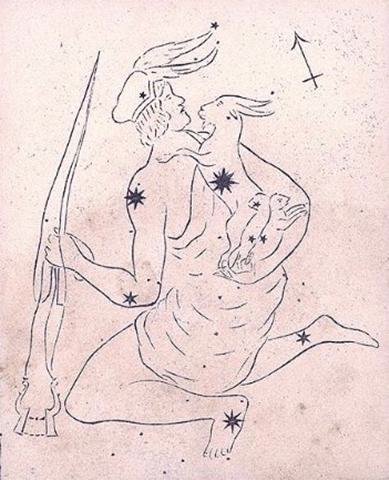
The second list
begins with Mem - water, and continues with
Nun - fish, Samek - fish bones, Ayin -
a water spring, Peh - the mouth of a well,
Tsadi - to fish, Kof, Resh and Shin
are the hook hole, hook head and hook teeth, known to
exist from prehistoric times, and the Tav is the
mark used to count the fish caught ...

The Nile had a delta (Δ)
awashed (tata) in water.

... Sorrowing, then, the two women placed Osiris's
coffer on a boat, and when the goddess Isis was alone
with it at sea, she opened the chest and, laying her
face on the face of her brother, kissed him and wept.
The myth goes on to tell of the blessed boat's arrival
in the marshes of the Delta, and of how Set, one night
hunting the boar by the light of the full moon,
discovered the sarcophagus and tore the body into
fourteen pieces, which he scattered abroad; so that,
once again, the goddess had a difficult task before her.
She was assisted, this time, however, by her little son
Horus, who had the head of a hawk, by the son of her
sister Nephtys, little Anubis, who had the head of a
jackal, and by Nephtys herself, the sister-bride of
their wicked brother Set. Anubis, the elder of the two
boys, had been conceived one very dark night, we are
told, when Osiris mistook Nephtys for Isis; so that by
some it is argued that the malice of Set must have been
inspired not by the public virtue and good name of the
noble culture hero, but by this domestic inadventure.
The younger, but true son, Horus, on the other hand, had
been more fortunately conceived - according to some,
when Isis lay upon her dead brother in the boat, or,
according to others, as she fluttered about the palace
pillar in the form of a bird. The four bereaved and
searching divinities, the two mothers and their two
sons, were joined by a fifth, the moon-god Thoth (who
appears sometimes in the form of an ibis-headed scribe,
at other times in the form of a baboon), and together
they found all of Osiris save his genital member, which
had been swallowed by a fish. They tightly swathed the
broken body in linen bandages, and when they performed
over it the rites that thereafter were to be continued
in Egypt in the ceremonial burial of kings, Isis fanned
the corpse with her wings and Osiris revived, to become
the ruler of the dead. He now sits majestically in the
underworld, in the Hall of the Two Truths, assisted by
forty-two assessors, one from each of the principal
districts of Egypt; and there he judges the souls of the
dead. These confess before him, and when their hearts
have been weighed in a balance against a feather,
receive, according to their lives, the reward of virtue
and the punishment of sin ...
 |
 |
 |
 |
 |
 |
 |
|
Bb9-21 |
Bb9-22
(348) |
Bb9-23 |
Bb9-24 |
Bb9-25 |
Bb9-26
(352) |
Bb9-27 |
|
RIGHT
ASCENSION DAYS AT THE FULL MOON: |
|
ρ Gemini
(112.1),
Eskimo Nebula = NGC2392 Gemini
(112.2)
ANTARES (α Scorpii) |
Al Dhirā'-5
(Forearm) /
Punarvasu-7
(The Two Restorers of Goods) /
Mash-mashu-Mahrū-10 (Western One of the
Twins)
CASTOR (Beaver) = α Gemini (113.4)
*113.4 = *41.4 + *72.0 |
ANA-TAHUA-VAHINE-O-TOA-TE-MANAVA-7 (Pillar
for Elocution)
υ Gemini (114.0),
MARKAB PUPPIS = κ Puppis
(114.7), ο Gemini (114.8),
PROCYON = α Canis Minoris
(114.9) |
α Monocerotis (115.4),
σ Gemini (115.7)
*74.0 = *115.4 - *41.4 |
Mash-mashu-arkū-11 (Eastern One of the
Twins)
κ Gemini (116.1),
POLLUX = β Gemini
(116.2), π Gemini (116.9) |
AZMIDISKE (Little Shield) =
ξ
Puppis (117.4)
*76.0 = *117.4 - *41.4 |
φ Gemini (118.4)
*77.0 = *118.4 - *41.4 |
 |
|
HELIACAL STARS: |
|
ν
Aquilae (Ant.) (295.0),
ALBIREO - Hen's Beak =
β
Cygni
(295.5) |
ALSAFI (Fire Tripod) =
σ
Draconis
(296.0),
μ
Aquilae (296.3),
ι
Aquilae (Ant.)
(296.8), κ Aquilae (Ant.) (296.9) |
ε Sagittae (297.1),
σ Aquilae (Ant.) (297.4),
SHAM (Arrow) = α Sagittae
(297.8)
*256.0
= *297.4 - *41.4 |
β Sagittae (298.0), χ Aquilae (298.3), ψ
Aquilae (298.8) |
υ Aquilae (299.1),
TARAZED (Star-striking Falcon) =
γ Aquilae
(299.3), δ Sagittae (299.6), π Aquilae
(299.9) |
Sravana-23 (Ear or
Three Footprints)
TYL =
ε
Draconis
(300.0),
ζ
Sagittae (300.1),
ALTAIR (Flying Eagle) =
α
Aquilae
(300.3),
ο
Aquilae (300.5),
BEZEK =
η
Aquilae (Ant.)
(300.8) |
ι Sagittarii (301.2),
TEREBELLUM = ω Sagittarii,
ξ Aquilae (301.3),
ALSHAIN (Falcon) = β Aquilae
(301.6), φ Aquilae (301.8) |

... so
completely is Aagjuuk identified with
mid-December and the winter solstice that
one Igloolik elder, invited to point
to the constellation in early November,
firmly replied that we would not see it
until around Christmas, and this in spite of
the fact that Altair was at the time in full
view to the southwest ... |
|
10 (314 +
61) |
11 (*´296) |
12 |
(378 →
Saturn) |
14 |
15 (*300) |
Jan 16 |
|
NOV 10
(314) |
11 (*232) |
12 |
(378 - 64
→ π) |
14 |
15 (*236) |
(320
→
Dramasa) |
|
ko te metimeti - ma to
ragi - kua hua ia i raro |
ma te hokohuki - ki te
henua |
kua haati ia e kava |
kava o te ariki |
e huarae - ma to rima -
ki te ragi |
e rere ia mai - ki to
huki |
ko to huki ka to ihe -
kua reva te ika |
|
Kava. 1. Sour; salty: vai kava,
saltwater, sea; te kava o te haíga,
acrid underarm smell; tagata kava -
tagata kakara i te kava, man with smelly
armpits. 2. He-kava te haha, to be
thirsty. 3. To turn sour, to become
embittered, bad-tempered, exasperated (used
with manava): tagata manava kava,
bad-tempered, angry man. Vanaga. Bitter,
salt; vai kava, brackish water;
hakakava, to embalm; kavakava,
acid, sharp, bitter, salt, spiritous,
vinegar, poisonous, disagreeable;
akavakava, to make sharp;
hakakavakava, to make acid. P Pau.:
kava, disagreeable to the taste;
kavakava, acid, sharp. Mgv.: kava,
to be bitter, sour, acid, salt. Mq.: kava,
bitter. Ta.: ava, bitter, acid, salt.
Kavahia: 1. Comfort, comfortable, to
feast; hakakavahia, comfort,
comfortable. 2. Repulsive (of food),
disgusted; hakakavahia, repulsion.
Kavakava, rib; moi kavakava, a
house god G. P Mgv.: vakavaka, the
breast. Mq.: vakavaka, vaávaá,
rib. Ma.: wakawaka, parallel ridges.
We shall need all the available material in
order to determine the germ sense of this
word. Sa.: va'ava'a, the breast-bone
of a bird; fa'ava'a, the frame as of
a slate. To.: vakavaka, the side.
Fu.: vakavaka, the side below the
armpit. Ha.: hoowaa, to make furrows.
In all these we may see the idea of ridge or
depression, or of both, as primal (Rapanui,
Samoa, Marquesas, Maori, Hawaii), and as
secondary the part of the body where such
appearances is common (Mangareva, Tonga,
Futuna). Churchill. Mgv.: kava, the
pepper plant and the drink made therefrom.
Ta.: ava, id. Mq.: kava, id.
Sa.: 'ava, id. Ma.: kawa, a
pepper. Kavakava, a fish. Sa.:
'ava'ava, id. Kavapui, a tree.
Ta.: avapuhi, a fragrant plant. Mq.:
kavapui, wild ginger. Sa.: 'avapui,
id. Ha.: awapuhi, id. Churchill. Mq.:
ava, a small fish of sweet water.
Sa.. 'ava'ava, a small fish. Ha.:
awa, a fish. Kakava, burnt. Sa.:
'a'ava, very hot. Churchill.
Reva
To hang down; flag, banner.
Revareva, 1. To be hanging vertically;
to detach oneself from the background of the
landscape, such a person standing on top of
a hill: ku-revareva-á te tagata i ruga i
te maúga. 2. To cast itself, to project
itself (of shadows); revareva-á te kohu o
te miro i te maeha o te mahina, the
shadow of the tree casts itself in the light
of the moon. 3. Uvula. Vanaga. To hang, to
suspend, flag, banner; hakareva, to
hang up; hakarereva, to hang up, to
balance; hakarevareva, to wave. T
Pau.: reva, a flag; fakarevareva,
to hang up, to suspend. Mgv.: reva, a
flag, a signal. Mq.: éva, to hang up,
to be suspended, to wave a signal. Ta.:
reva, a flag, banner; revareva,
to wave. The germ sense is that of being
suspended ... any light object hung up in
the island air under the steady tradewind
will flutter; therefore the specification
involved in the wave sense is no more than
normal observation. Churchill. Mgv.: 1. A
plant. Ta.: reva, id. Mq.: eva,
id. Sa.: leva, id. Ma.: rewa-rewa,
id. 2. To cross, to pass across quickly;
revaga, departure. Ta.: reva, to
go away, to depart. Ma.: reva, to get
under way. Churchill. Ta.: The firmanent,
atmosphere. Ha.: lewa, the upper
regions of the air, atmosphere, the visible
heavens. Churchill.
Ika
1. Fish. 2. In some cases, animal in
general: îka ariga koreh[v?]a, animal
with the face of a koreva fish (name
given to horses when they arrived on the
island, because of the resemblance of their
heads with that of a koreva). 3.
Victim (wounded or killed), enemy who must
be killed, person cursed by a timo
and destined to die; îka reirei,
vanquished enemy, who is kicked (rei).
4. Corpse of man fallen in war. Vanaga. 1.
Fish, animal; ika rere, flying fish;
ivi ika, fishbone; mata ika,
pearl. P Pau., Mgv., Mq.: ika, fish.
Ta.: ia, id. 2. Prey, victim,
sacrifice; ika ke avai mo, abuse;
hakarere ki te ika, to avenge. T Mgv.:
ikaiara, to quarrel; ikatamamea,
to be angry because another has handled
one's property. Mq.: ika, enemy, what
causes horror. Ma.: ika, the first
person killed in a fight. Mangaia: ika,
a victim for sacrifice. 3? matamata ika,
snow. Ikahi, to fish with a line, to
angle. Mq.: ikahi, id. Ikakato,
to go fishing. Ikakohau, to fish with
a line, to angle. Ikapotu, cape, end
of a voyage, destination; ikapotu
hakarere, to abut, to adjoin; topa te
ikapotu, id.; tehe oho te ikapotu,
id.; mei nei tehe i oho mai ai inei te
ikapotu, as far as, to. Ikapuhi,
to fish with a torch. Mq.: ikapuhi,
id. Churchill. |
At Φ Gemini, 5 days after
Castor, the season of the Fish (nūn) or Snake (nahš)
was going away (reva). We can count 54 days from
Zaurak to the night when
Antares culminated (at 21h). Day 54 was February 23 (Terminalia).
365 + 54 = 7 * 60 - 1.
|
 |
 |
*53 |
 |
 |
|
ZAURAK |
VRISCHIKA |
ANTARES
|
CASTOR |
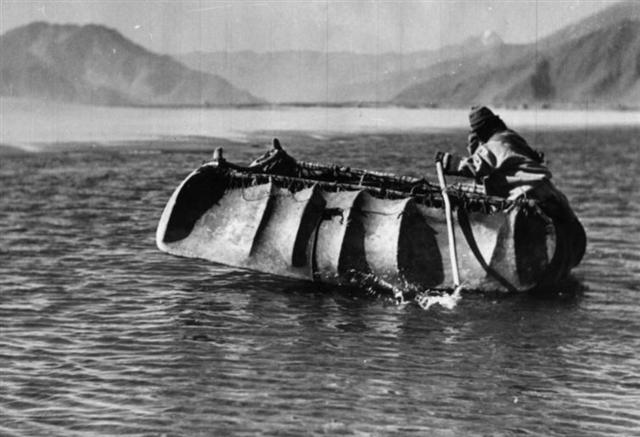
North of the equator the day after
Terminalia (February 23) was doubled
(Bissextum), and south of the equator - where the
seasons were upside down - a kind of logic could
therefore state that before Terminalia a pair
of nights were doubled.
 |
 |
 |
 |
*52 |
 |
 |
VINDEMIATRIX |
HYADUM I |
YED POSTERIOR |
AIN (*65) |
ALTAIR |
Φ Gemini |
5 nights after the Full Moon had been at Pollux
the Full Moon would be at Naos, and 5 days after
the Sun had been at Tarazed (the Star-striking
Falcon, γ Aquilae) the Sun would be at 20h:
 |
 |
 |
 |
 |
|
Bb9-28 (354) |
Bb9-29 |
Bb9-30 |
Bb9-31 |
Bb9-32 |
|
RIGHT ASCENSION DAYS AT THE FULL
MOON: |
|
DRUS
(Hard) = χ Carinae
(119.9) |
ω Cancri
(120.2) |
8h (121.7)
χ
Gemini (121.0),
NAOS (Ship) =
ζ
Puppis
(121.3) |
ρ
Puppis (122.0),
HEAP OF FUEL =
μ
Cancri
(122.1),
ζ
Monocerotis (122.3), ψ
Cancri (122.6),
REGOR (Roger backwards) =
γ
Velorum
(122.7) |
TEGMINE (The Cover) =
ζ
Cancri
(123.3) |
.jpg)
... After they had departed from
Pu Pakakina they reached Vai
Marama and met a man. Ira
asked, 'How many are you?'
He
answered, 'There are two of us.'
Ira continued asking, 'Where is
he (the other)?' To that he
answered, 'The one died.' Again
Ira asked, 'Who has died?' He
replied, 'That was Te Ohiro A Te
Runu.' Ira asked anew,
'And who are your?' He answered, 'Nga
Tavake A Te Rona.' [E:46]
... Nga
Tavake spoke to Te
Ohiro: 'The land is
sinking into the sea and we are
lost!' ...

|
|
HELIACAL STARS: |
|
ε Pavonis, θ Sagittarii (302.3), γ
Sagittae (302.5), μ Pavonis (302.7) |
τ Aquilae
(303.8) |
20h (304.4)
304.4 = 118.4 + 186.0
η Sagittae
(304.2),
δ Pavonis (304.4)
*263.0 = *77.0 + *186.0 |
SHANG WEI (Higher Guard) =
κ
Cephei
(305.2),
θ
Sagittae (305.4),
TSEEN FOO (Heavenly Raft) =
θ
Aquilae (Ant.)
(305.6), ξ Capricorni (305.8)
*264.0 = *305.4 - *41.4 |
TSO KE (Left Flag) =
ρ
Aquilae
(306.3) |
 |
|
Jan 17 |
18 |
19 (320 + 64) |
20 |
21 (*306) |
|
NOV 17 (321) |
18 |
19 (*240 = 232 - 83) |
20 |
21 (*242 = 325 - 83) |
|
... Ancient references to a south
pole are of course infrequent; Ovid,
howevever, makes Phoebus allude to
it in his instructions to Phaëton
... and Pliny tells us that the
Hindus had given it a name,
Dramasa ... |
|
kua hahaú ia
koia |
e rere koia |
ki ruga mai
kia au |
kua rere mai
ki te toga |
eaha te manu
rere toki - ki te henua |
... Why has the
Left Flag (Tso Ke, ρ Aquilae)
not been indicated in the star map
for Aquila? It looks
suspicious ...
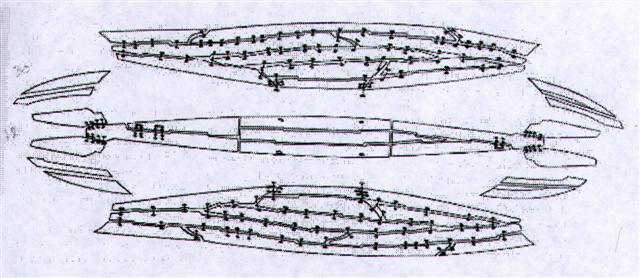 |
 |
 |
 |
 |
 |
 |
 |
|
Ga3-1 (60) |
Ga3-2 |
Ga3-3 |
Ga3-4 |
Ga3-5 |
Ga3-6 |
Ga3-7 (66) |
|
MAY 20 (140) |
21 |
22 |
23 |
24 |
25 (145) |
26 |
 |
 |
 |
 |
 |
 |
 |
|
Bb9-33 (359) |
Bb9-34 |
Bb9-35 |
Bb9-36 |
Bb9-37 |
Bb9-38 (364) |
Bb9-39 |
|
AL TARF (The End) =
β
Cancri
(124.3)
RAS ALGETHI (α Herculis) |
χ
Cancri (125.2),
BRIGHT FIRE =
λ
Cancri (125.4)
*84.0 = *125.4 - *41.4 |
AVIOR =
ε
Carinae (126.4),
φ
Cancri (126.8)
*85.0 = *126.4 - *41.4 |
Ο
Ursae Majoris (127.4)
*86.0 = *127.4 - *41.4 |
Pushya-8 (Nourisher)
υ Cancri (128.1),
θ
Cancri (128.2) |
Āshleshā-9 (Embrace)
/
Willow-24 (Stag)
π¹ Ursa Majoris,
δ HYDRAE (129.6),
AL MINHAR AL SHUJĀ
= σ Hydrae, MUSEIDA = π² Ursae
Majoris
(129.9)
RAS ALHAGUE (α Ophiuchi) |
Al
Nathrah-6 (Gap)
BEEHIVE (Exhalation of Piled-up
Corpses) = ε Cancri,
η Pyxidis (130.4), XESTUS = ο
Velorum
(130.5), ζ Pyxidis (130.7),
ASCELLUS BOREALIS = γ Cancri,
β Pyxidis (130.9)
*89.0 = *130.4 - *41.4 |
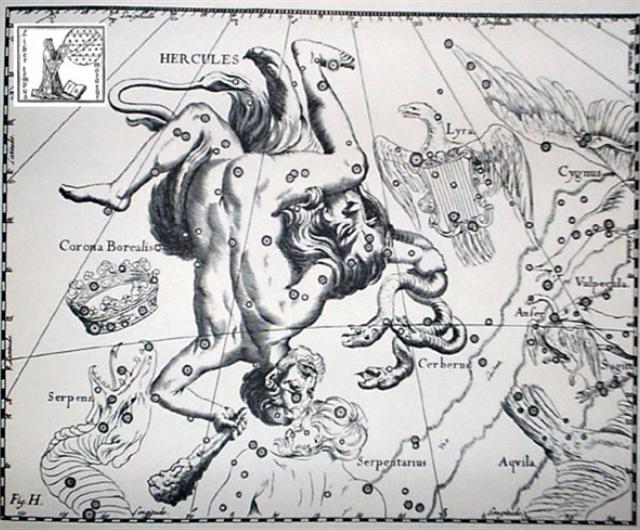 |
|
July 23 (204) |
24 |
25 |
26 |
27 |
28 |
29 (210) |
|
22 (326 + 61) |
23 |
24 |
25 (390) |
26 |
27 (365 + 27) |
Jan
28 (393) |
|
NOV 22 (326) |
23 |
24 |
25 (390 - 61) |
26 |
27 (*248) |
28 → Lono |
|
The Hawaiians
counted 10 days from November 18 to
November 28 in order to find the
beginning of the cycle of Lono.
Assuming glyph number 355 (→
December solstice) on side b of the
B text corresponded to their
November 18, we should look at glyph
number 365. |
|
eaha te manu
rere |
ki te hokohuki |
kua haga i te
mea ke |
ki te tuuga o
to toga |
e tagata rere |
mai ki te
totoga e |
kua haga ko te
mea ke |

 |
 |
 |
|
Bb9-40
(→ 365¼) |
Bb9-41 |
Bb9-42 |
|
Extended Net-26a
(Ox) /
Arkū-sha-nangaru-sha-shūtu-12 (Southeast
Star in the Crab)
η
Hydrae (131.0),
ASCELLUS AUSTRALIS =
δ
Cancri (131.4),
KOO SHE =
Bow and Arrow
=
δ
Velorum
(131.6),
α
Pyxidis (131.8),
ε
Hydrae (131.9)
*90.0 = *131.4 - *41.4 |
ι Cancri (132.0),
ρ
Hydrae (132.4)
*91.0 = *132.4 - *41.4 |
γ Pyxidis (133.6) |
|
July 30 |
31 |
Aug 1
(213) |
|
Jan 29 |
30 |
31 (396) |
|
NOV 29
(*250 = *131 + *183 - *64) |
30 (334) |
DEC 1
(396 - 61) |
|
o tagata itiiti |
kua moe mai kia ia - kua
moe i te ragi |
kua hua ia mai - ki te
henua |
|
Iti. Little, small,
medium; iti atu, less; iti no,
small quantity, rare; no iti,
superficial. Itia, shrunken.
Itiiti, scanty, slim; hare itiiti no,
cabin; itiiti noa, mediocre,
mediocricity. Hakaiti, to make small,
to lessen, to weaken, to impoverish, to thin
out, to reduced, to diminish, to retrench,
to curtail, to subdue, to mitigate, to
abate. Hakaitiiti, to squat, to
croach. P Mgv.: iti, small. Mq.:
iti, id. Ta.: iti, id. Churchill. |
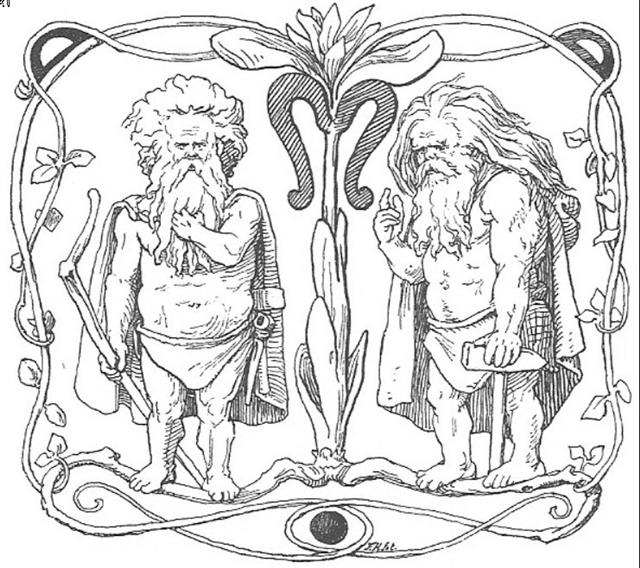
 |
 |
 |
 |
 |
 |
|
Bb9-43 |
Bb9-44 |
Bb9-45 |
Bb9-46 |
Bb9-47 |
Bb9-48 |
|
ζ
Hydrae (134.1),
ρ
Cancri (134.2),
ζ
Oct.
(134.3), ο Cancri (134.6), δ Pyxidis (134.9) |
ACUBENS = α Cancri,
TALITHA BOREALIS = ι Ursae Majoris
(135.0), σ Cancri (135.2), ρ Ursa Majoris (135.6) |
ν
Cancri (136.0),
TALITHA AUSTRALIS = κ Ursae Majoris
(136.1), ω Hydrae (136.8) |
9h (137.0)
σ¹ Ursa Majoris (137.0), κ Cancri (137.3),
τ Cancri (137.4),
ALSUHAIL (al
Wazn, of the Weight) = λ Velorum
(137.5),
σ² Ursa Majoris (137.6), τ Ursa Majoris (137.7), ξ Cancri (137.8)
*96.0 = *137.4 - *41.4 |
κ
Pyxidis (138.0), ε Pyxidis (138.5) |
π
Cancri (139.2),
MIAPLACIDUS =
β
Carinae
(139.3),
TUREIS (Little Shield) =
ι
Carinae
(139.8) |
|
Aug 2 (214) |
3 |
4 (2 * 108) |
5 |
6 |
7 |
|
Febr 1 (32) |
2 |
3 (*319) |
4 (400) |
5 |
6 |
|
DEC 2 (4 * 84) |
3 (337) |
4 (*255) |
5 |
6 |
7 |
| kua hua ko te
poporo |
koia kua ea ki te
marama |
kua haati
hia e kava |
e kava
iri ia ra |
ko te
tagata itiiti mau rima
ra |
eaha te manu iti pepepepe - mau i te hokohuki |
|
Iri. 1. To go up; to go in a boat on the sea
(the surface of which gives the impression of going up from the
coast): he-eke te tagata ki ruga ki te vaka, he-iri ki te
Hakakaiga, the men boarded the boat and went up to Hakakainga.
2. Ka-iri ki puku toiri ka toiri. Obscure expression of an
ancient curse. Vanaga. Iri-are, a seaweed. Vanaga.
Pepe. 1.
A sketch. 2. Bench, chair, couch, seat, sofa, saddle; here pepe,
mau pepe, to saddle; noho pepe, a tabouret.
Pepepepe, bedstead. 3. Pau.: butterfly. Ta.: pepe, id.
Mq.: pepe, id. Sa.: pepe, id. Ma.: pepe, a
moth; pepererau, fin, Mgv.: pererau, wing. Ta.:
pereraru, id. Ma.: parirau, id. Harepepe, kelp.
Here pepe, to saddle. Churchill. Sa.: pepe, a butterfly,
a moth, to flutter about. Nukuoro, Fu., Niuē,
Uvea, Fotuna, Nuguria, Ta., Mq.: pepe,
a butterfly. Ma.: pepe, a
grup, a moth; pepepepe, a
butterfly; pepeatua, a
species of butterfly. To.: bebe,
a butterfly. Vi.: mbèbè,
a butterfly. Rotumā: pep,
id. Churchill 2. Mq.: Pepepepe, low, flat. Ha.:
pepepe, id. Churchill. |
 |
 |
|
Bb9-49 |
Bb9-50 |
|
No
star listed (140) |
θ
Pyxidis (141.5),
MARKAB VELORUM =
κ
Velorum
(141.5),
AL MINHAR AL ASAD (The Nose of the Lion)
=
κ
Leonis
(141.6),
λ
Pyxidis (141.9) |
|
Aug 8 (220) |
9 |
|
Febr 7 (342 + 61) |
8 (404) |
|
DEC 8 (342) |
9 (*260 = *324 - *64) |
|
erua ika |
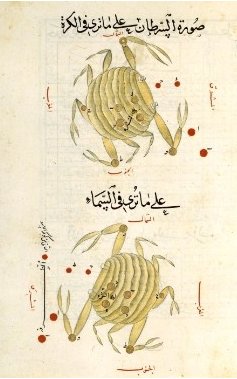
|











.jpg)






















.jpg)


